[Enjoy this guest post by Jack Gann! – Ed.]
Watching any of the four adaptations of Jane Eyre to appear on screen in the last twenty years, have you felt a lack of vampires? Or zombies? Or any other creatures of the night? The ever expanding literature – fantasy monster mash-up genre thinks so. In the style of Pride and Prejudice and Zombies or Android Karenina, Sherri Browning Erwin’s Jane Slayre rewrites Charlotte Brontë’s novel to make the heroine into a badass monster fighter. Monsters, though, have always been a part of Jane Eyre’s story.
In this article I will look at three print versions of the Jane Eyre story: the 19th century original, Jean Rhys’s prequel/fanfic Wide Sargasso Sea from the 20th century, and Jane Slayre from the 21st. Each novel uses a different supernatural creature to characterize Bertha Mason, the madwoman in the attic: a vampire for Brontë, a zombie for Rhys and a werewolf for Erwin. In this progression we can see the changing social and cultural climate of each century and how that has changed people’s fears.
Even by the standards of her day, Jane Eyre lives an extraordinarily sheltered existence, shut away as a child at home by her guardians at Gateshead, then sent to study and teach at Lowood School. By the time she hits adulthood, Jane has no experience of the world beyond these two small, sealed environments. When she becomes governess at Thornfield and goes on to meet Mr. Rochester (like Fitzwilliam Darcy, Edward Fairfax Rochester is doomed to have pop culture forever perceive his first name as “Mister”) he is the first eligible adult man she has ever spoken to.
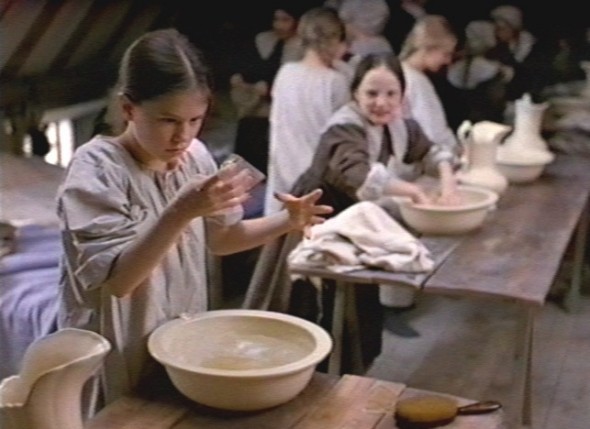
Without real social interaction, Jane grows up seeing the world through fairy stories and popular literature. Although she is impressively mature in many ways, Jane’s imaginative vocabulary for understanding the wider world centers on fantastic creatures and images. As she says: “I was young, and all sorts of fancies bright and dark tenanted my mind: the memories of nursery stories were there amongst other rubbish; and when they recurred, maturing youth added to them a vigour and vividness beyond what childhood could give.”
This description is Jane’s justification of her feeling at her first encounter with Rochester. She perceives his giant beastly dog emerging before him on the icy, misty road and thinks of: “a North-of-England spirit, called a ‘Gytrash’; which, in the form of horse, mule or large dog, haunted solitary ways, and sometimes came upon belated travellers”. Rochester himself later recalls similar thoughts in the same situation, accusing Jane of using her fairy magic to conjure ice to make his horse stumble: “The men in green: it was a proper moonlight evening for them. Did I break one of your rings, that you caused that damned ice on the causeway?”
Although she has heard many strange noises around the gothic corridors of Thornfield, Jane does not see Rochester’s mad first wife Bertha until the night before her own disastrous wedding. Bertha creeps into Jane’s room and Jane catches her “fearful and ghastly” reflection in the mirror. Jane is in no doubt of what the figure with “black eyebrows widely raised over the bloodshot eyes” reminds her of: “the foul German spectre – the vampire”. This is the only time the v-word itself is mentioned, but Bertha’s vampiric behavior is obvious elsewhere. An encounter with her brother Richard has him remarking in horror: “She sucked the blood: she said she’d drain my heart”.
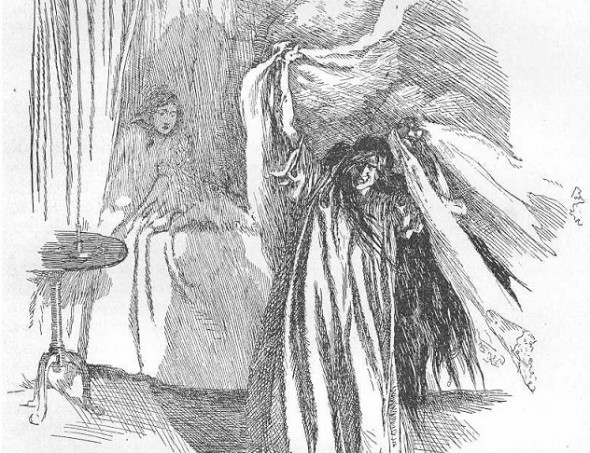
In the 1700s vampires had been described by Voltaire’s Philosophical Dictionary as: “corpses, who went out of their graves at night to suck the blood of the living […] after which they returned to their cemeteries”. The 19th century reconfigured the vampire from a graveyard ghoul into the image of the greatest icon of the era, lover/fighter/poet/revolutionary/athlete/relentless self-promoter George Gordon, Lord Byron. Indeed, most modern vampire stories can be traced back to Byron, whose contribution to the ghost story contest that resulted in Mary Wollstonecraft Godwin’s Frankenstein was an autobiographical vampire tale. Expanded by Byron’s doctor, John Polidori, “The Vampyre” became hugely popular across Europe and helped create the modern image of the vampire – a suave, brooding, sexually desirable aristocrat.
The vampire was the perfect hero for Byron and the Romantic movement: a tormented soul wandering to escape his dark past and offering the combined allure and threat of the exotic and the explicitly sensual in the face of traditional Christian morals and standards. In the years before Jane Eyre was written, an English translation of Goethe’s “The Bride of Corinth,” a story in which a female vampire seduces a Christian, appeared for the first time, while the popular “penny dreadful” at the time was Varney the Vampire, in which vampirism is a fairly transparent rape analogy but the “can’t help himself” protagonist is supposed to retain some audience sympathy. This is the context for avid Byron admirer Brontë’s vampire reference.
Vampirism is a sexual threat. Bertha is described as: “intemperate and unchaste […] gross, impure, depraved”, her madness a predatory nymphomania. For the 19th century Romantics, this engendered the fear of being taken over themselves by this sexually transmitted depravity. After his marriage to Bertha, Rochester assumes the characteristics of the Byronic vampire. Like Byron he has the dark exoticism, the tortured European wanderings full of the kind of sexual encounters that have given him an unwanted bastard child, even the propensity for “oriental” fancy dress.
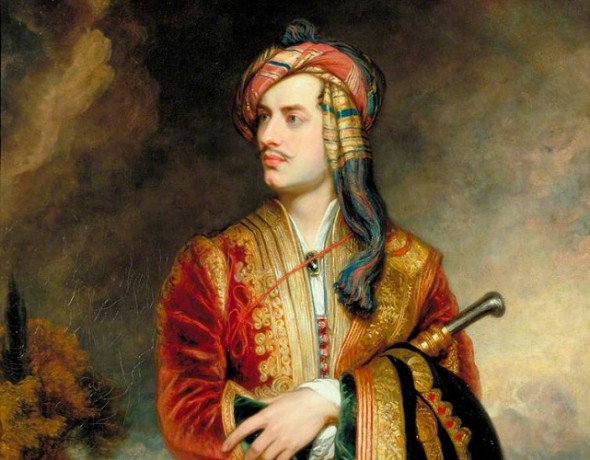
Although the story ultimately resolves itself as a love story, there remains a dark and threatening side to Rochester amongst his brooding virility. Like many vampires, Bertha goes down in flames. It is only this fire that cleanses Rochester’s own vampiric side. Only then is Jane safe to marry him.
Society changed greatly in the 20th century, as did our fears and monsters. In 1968 Night of the Living Dead defined the zombie in the modern cultural imagination against a backdrop of Cold War paranoia, Vietnam War critique and civil rights advocacy. Two years earlier Dominican novelist Jean Rhys had reimagined vampire Bertha as zombie Antoinette, reflecting the new artistic principles of her age by providing a voice and perspective to this once predatory creature.
In Wide Sargasso Sea, Rhys tackles the race and gender politics of Bertha’s voiceless character in a multi-perspective story that uses the Caribbean religion of obeah to illuminate clashes of culture and ideas of madness (although arguably many of the same themes were explored better twenty years earlier in the similarly Jane Eyre-inspired I Walked With a Zombie). To this end, the book is packed with reference to “zombis” (no “e”), the living dead in obeah culture.
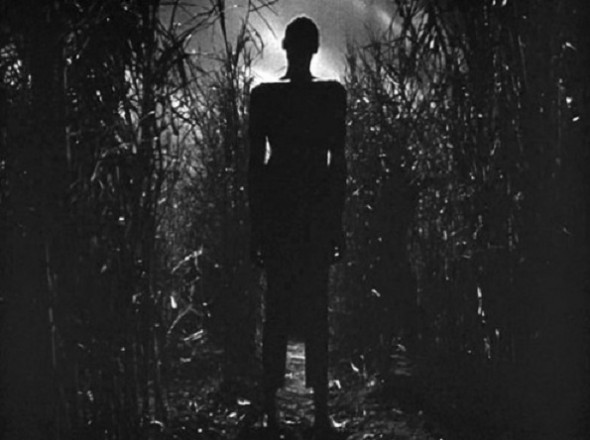
In one scene, a girl compares the young Antoinette/Bertha to her supposedly mad mother, saying: “She have eyes like zombi and you have eyes like zombi too”. Antoinette fears becoming like her mother—like a zombie. While a vampire is a creature with agency and power, a zombie is numb and devoid of personality. The fear for Jane Eyre’s 19th century audience was Bertha’s vampirism infecting them with her lascivious violence. In making her the protagonist, the fear in Rhys’ book is that of Bertha herself, that the madness may grow inside her rather than be forced from outside. The madness of a zombie in the 20th century, though, is different from that of a vampire a century earlier.
During a time when an emerging sense of identity for minority groups was linked to their growing voice in society and when the ascendency of psychoanalysis meant a greater focus on everyone’s own sense of identity, Antoinette/Bertha’s fear of madness and her morbid curiosity about death is reflected in the zombie’s threat completely to eradicate her identity. Once you become a zombie you become completely nothing. Zombie narratives like I Walked With a Zombie, Night of the Living Dead, Dawn of the Dead and Wide Sargasso Sea reacted to the mid-20th century pressure to give representation to non-white, non-male individuals by making them the center of a story whose monsters threatened to take that identity away for good.
21st century audiences, however, respond differently to the kind of monster threat established in Night of the Living Dead. In 2004, Romero zombie tribute Shaun of the Dead had protagonist Shaun explicitly tell his best friend Ed not to use “the z-word” because “it’s ridiculous”. There are possibly more zombies on screen now than ever before, but many of these interpretations do not use them as a serious threat, giving us instead zombies as friends (Wasting Away) or pets (Fido). Prior to the recent success of World War Z (which uses the pandemic of rabid infected zombies more than the 20th century Romero variety) BoxOfficeMojo listed the three most successful zombie films as an animated family comedy (Hotel Transylvania), a teen comedy (Zombieland) and a romance (Warm Bodies).
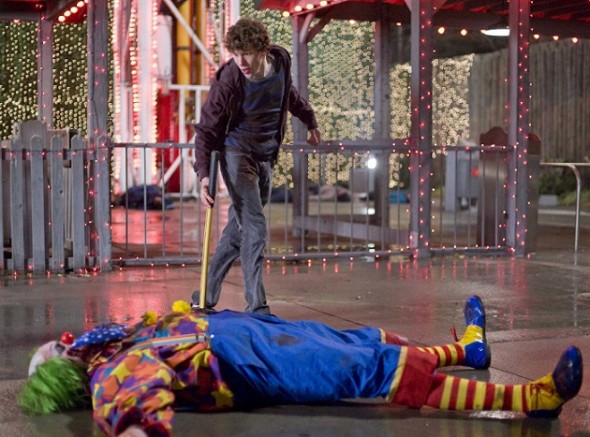
This intent to insert zombies and other monsters into different types of story has birthed the mash-up genre that first came to prominence with Pride and Prejudice and Zombies. These mash-up books seek to tear apart “stuffy old” classics with 21st century pop culture, injecting violent monster fights into the familiar narratives. Jane Slayre’s monsters, therefore, are not the figurative kind. In this third version of the story, Bertha is rendered literally as a werewolf, as this Jane discovers at the climactic reveal: “I remembered such a creature from fairy stories Bessie had told me in my youth, a creature with a curse of transforming from human to wolf under the glow of a full moon. A werewolf.” What, then, can werewolf Bertha tell us about our current preoccupations and fears that vampire Bertha did for the 19th century of zombie Bertha for the 20th?
Jane Slayre’s jokey co-writing credits (in the style of other books of this type, it is credited to “Charlotte Brontë and Sherri Browning Erwin”) are a testament to how the mash-up novel’s writing process is essentially an editing over the original text. Often this results in a jarring inconsistency of tone and storytelling style in which classic elegant prose is awkwardly juxtaposed with a rushed hack job. The werewolf Bertha is symbolic of this have-your-cake-and-eat-it-too dual identity, an elegant period drama lady switched on and off into a simplistic savage beast.
Typically werewolves in popular 21st century narratives occupy this position of nice guy/girl 90% of the time, monster only occasionally, rendering them a figure of lesser narrative interest than the likes of old fashioned vampires. In Buffy you have werewolf Oz in the beta couple against the leading role played by vampire Angel, Twilight’s Jacob is overlooked in favour of Edward, Being Human’s Mitchell and secret vampire societies provide the overall narrative arcs and big bads in every season, not werewolf George. Even facing off directly against each other, as in the vampires vs. werewolves franchise Underworld, it is the apparently technologically and intellectually superior vampires who provide the narrative focus.
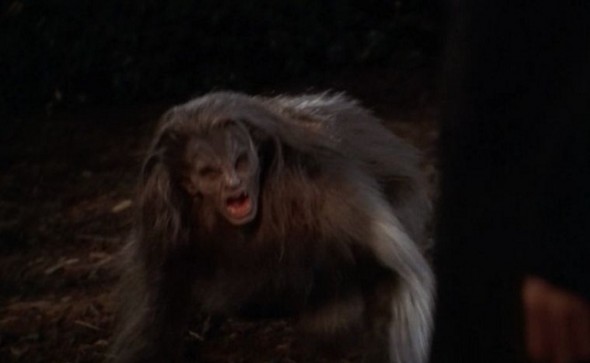
If werewolves typically play second fiddle in monster narratives, then they are likely to provide a lesser threat. As Erwin slashes Brontë’s text to something considerably shorter and more concise, so does werewolf Bertha provide much less problem to Erwin’s Jane than vampire Bertha did, dispatched in literally half the time (judging by page count). Erwin’s downgrading of Bertha to what 21st century audiences appear to consider a “lesser” monster downgrades her threat. Ironically in adding literal monsters in place of the allegorical ones in previous versions of the story Erwin has made something less scary. Like the zombies of Shaun of the Dead or Zombieland, Erwin’s werewolf is a creature of postmodern fun, not emotional danger.
So, what does the future of Jane Eyre’s monsters hold? It is impossible to know what type of creature she’ll have to fight when a future writer tailors the story to her (or his) generation. What is certain, though, is that whatever monster adversary Jane faces next, it will be one that tells us more about its writer’s time than it does about Jane’s.
Jack Gann works in a history museum by day and cooks unusual recipes by night. He writes about food, history and science on his blog and about movies and TV at whatculture.

All these tropes are the reflections of their times. Vampires have always been sexual, the transfer of bloodborne diseases have generated the greatest fears. It’s no coincidence that the vampire myth waxes and wanes on the state of health of the general population vis a vis STD’s.
Werewolves OTOH, seem to orbit on violence. War and heightened violence seem to be the watchwords, uncontrolled rage and “letting the beast out” would be good allegories to the age. It’s a little vague though because there isn’t any particular period identified and the werewolf myth doesn’t seem to wax much. It’s there as a secondary effect, never as a dominate.
Zombies are relatively new as a dominate myth. I credit that to the general fear of destruction of quality of life. The Corporate World and gov’ts around the world are rewriting the rules on how everyone lives without any input by those affected. You WILL conform, done with vicious indifference, the changes sucking the life right out of you. You end up staggering around, putting one foot ahead of the other just to get through the day, not able to fight or plan for the next year, overwhelmed by day to day challenges. And yet there’s no target, nothing that allows you to say, I can defeat this and get back on track. It certainly makes the allegory of zombies easy to find appealing in pop culture.
Hmmm, werewolves vs vampires. The real difference, most of the time, is one of ‘self’. A vampire is a fully integrated personality: once bitten/turned, the one person they are is a vampire and they are a vampire all the time. They need to drink blood (ie. commit violence/murder) and do so consciously. Werewolves, however, are two people: the human and the wolf. They go about their daily lives like anyone else, but on the full moon are transformed into a monster of pure violence. The human can slightly control the wolf through preparation (eg. locking itself up), but once they are a wolf, the human has no control. Any crimes committed are involuntary. Hence the ethical dilemma for the monster hunter; one which is definitely shown in treatments like Buffy. The Scoobies have no qualms about dusting vampires left, right and centre, but they goes to elaborate lengths to protect the presumably-more-easily-subdued Oz, because Oz himself is essentially innocent.
From Bertha’s perspective, it would look very similar to become a zombie as to become a werewolf. In one way or another, she is succumbing to a madness that makes her lose her self. As the zombie, she will eventually lose herself completely forever. As a werewolf, she will lose herself completely for regular periods of time, but then return to her self. This has the downside of seeing the aftermath and knowing the guilt. But Jane Slayre, which I haven’t read btw, doesn’t seem to be from Bertha’s perspective.
Jane is always facing some sort of monster, but apparently has no qualms about the death of either, despite the fact that she sees being a werewolf as a ‘curse’. Moreover, from the title, I’m guessing that Jane ‘Slayre’ takes a rather more active and energetic role in the destruction of Bertha. So is the latter depiction telling us more about the disregard of innocent human life, as long as, at some time, it represents a threat?
I’m going to be completely honest. I found the logic of this post a little difficult to follow.
First a small point. I think it’s a mistake to write off all of Jane’s interactions with people prior to Thornfield simply because they didn’t happen with eligible adult men. I think Jane draws less from more academic texts because of the people she interacts with and the freedom she has to question the things that she reads and learns about. I would tie a lot of her love of folktales and mythology to Bessie, one of the few characters to show her affection and attention early in her life. She also has a complicated relationship with religion.
As to the discussion of vampires, while it’s fairly clear that Bertha is being compared to a vampire I’m not sure I entirely agree with your reading. I don’t think the vampiric qualities that you’ve ascribed to him are the things that make Rochester threatening. The things that make Rochester a threat to Jane are wrapped up in power, identity, and morality. She fears her loss of identity and the fluidity of his. She isn’t threatened by his sexuality but the temptation to become his mistress when she learns about Bertha. It’s no accident that part of the resolution of the story is not just the fire but the fact that Jane receives her inheritance while Rochester has been ruined and this character who was once characterized by virility and strength is injured and Jane becomes his caretaker.
I think what’s interesting about Bronte’s take on the vampire as far as Bertha goes is that it’s not seductive which is what you would expect from the Byronic model (and also Dracula). Bertha as a vampire is almost a wild animal and she embodies Jane’s fears about her uncontrollable rage and impulses. The way her vampirism is tied to her sexuality is “masculine.” It’s aggressive and violent. Unlike small, pale Jane, Bertha is tall and strong and her wildness gives her the strength to spar with Rochester as a physical equal. I don’t think Bertha is threatening because she could possibly infect the characters with lascivious violence but because while she exists, she serves as a reminder of a lot of different things both Jane and Rochester would prefer to forget.
I wish you’d discussed Wide Sargasso Sea a little more as I think it bears closer scrutiny. Yes, the novel is concerned with the loss of identity but I don’t think you can talk about her loss of identity without talking about how complicated that identity is.